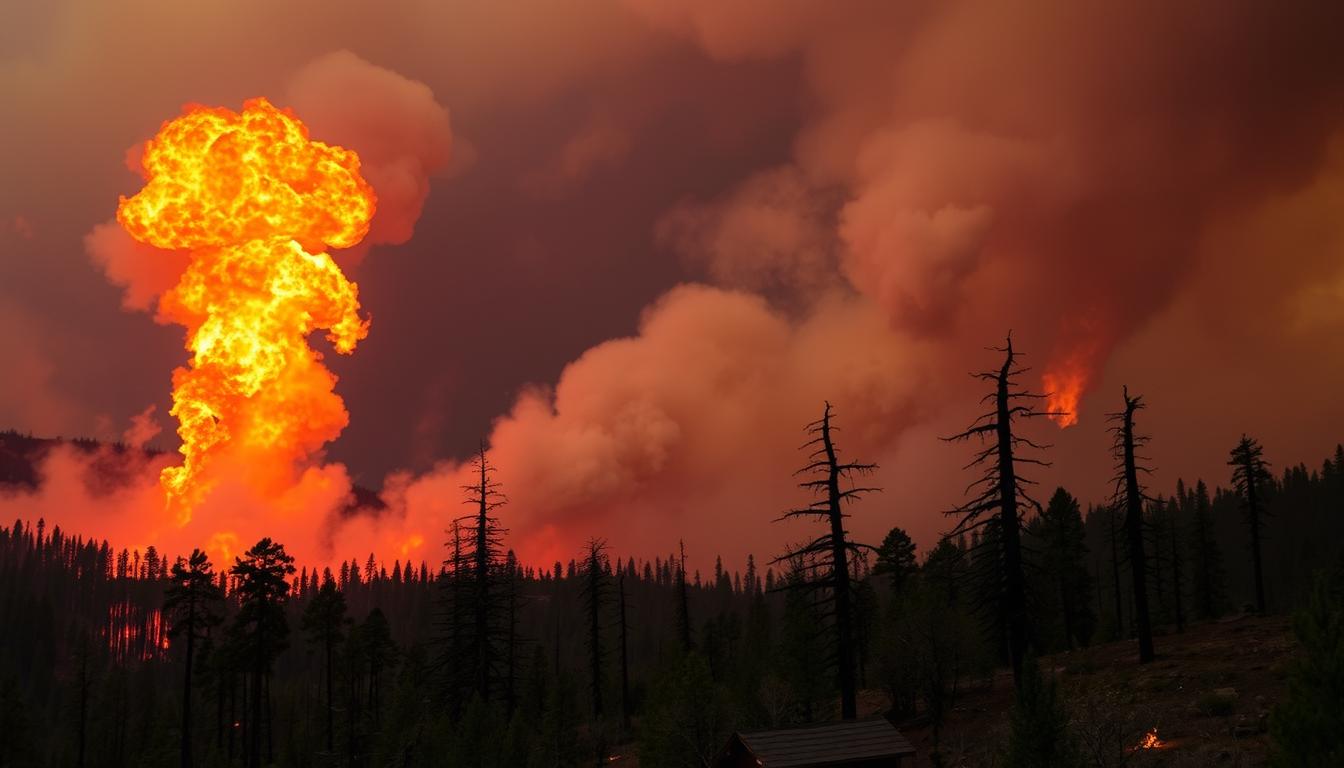The Rim Fire, one of the most devastating California wildfires, occurred in 2013, burning over 257,000 acres of land in the Sierra Nevada mountains. The cause of the Rim fire in California was a hunter’s illegal campfire, which spread quickly due to strong winds and dry conditions, leading to a thorough Rim fire investigation. This incident is a prime example of the destructive power of California wildfires.
Understanding what caused the Rim fire in California is crucial in preventing similar disasters. The investigation into the fire’s cause was led by the U.S. Forest Service, with assistance from local law enforcement agencies, as part of a broader effort to mitigate the impact of California wildfires. The Rim fire investigation revealed that human activity played a significant role in the fire’s ignition and spread.
The Rim fire in California had a profound impact on the environment and local communities, highlighting the need for effective strategies to prevent and manage California wildfires. By examining the circumstances surrounding the Rim fire, we can gain valuable insights into the causes of such disasters and the importance of a thorough Rim fire investigation.
Key Takeaways
- The Rim Fire was a massive wildfire that occurred in 2013 in the Sierra Nevada mountains.
- The cause of the Rim fire in California was a hunter’s illegal campfire.
- The Rim fire investigation was led by the U.S. Forest Service, with assistance from local law enforcement agencies.
- Human activity played a significant role in the fire’s ignition and spread.
- Understanding the causes of California wildfires is crucial in preventing similar disasters.
- A thorough Rim fire investigation is essential in developing effective strategies to mitigate the impact of such disasters.
Overview of the Rim Fire Incident
The Rim Fire, a devastating wildfire that occurred in California, had a profound impact on the environment and local communities. The fire, which started on August 17, 2013, burned for over two months, resulting in significant Rim fire damage assessment efforts. The Rim fire environmental impact was substantial, with thousands of acres of forestland burned and several wildlife habitats destroyed.
During the fire, Rim fire containment efforts were put in place to mitigate the spread of the fire. Despite these efforts, the fire continued to spread, affecting several communities, including Groveland, Tuolumne City, and Sonora. Many residents were forced to evacuate their homes, resulting in significant social and economic impacts.
- August 17, 2013: The fire started in the Stanislaus National Forest
- August 19, 2013: The fire spread to the Yosemite National Park
- September 2013: The fire was finally contained, but not before burning over 250,000 acres of land
The affected areas and communities are still recovering from the devastating effects of the Rim Fire, with ongoingRim fire containment effortsandRim fire damage assessmentinitiatives in place to restore the environment and support local communities.
Background of Wildfires in California
California has a long history of wildfires, with many fires occurring in the state’s dry and hot summers. Understanding the historical context of wildfires is crucial for developing effective California wildfire prevention efforts. The Rim fire causes analysis has shown that human activity, such as arson and accidental ignition, are common causes of wildfires in the state.
The role of climate change in exacerbating wildfires in California cannot be overstated. Rising temperatures and changing precipitation patterns have created conditions that are ripe for wildfires. Climate change has led to an increase in the frequency and severity of wildfires, making it essential to develop strategies for prevention and mitigation.
- Human activity, such as arson and accidental ignition
- Natural causes, such as lightning strikes
- Climate change, which has led to an increase in the frequency and severity of wildfires
By understanding the historical context of wildfires and the common causes of these fires, California can develop effective strategies for prevention and mitigation, ultimately reducing the risk of devastating wildfires like the Rim fire.
Investigating the Cause of the Rim Fire
The Rim fire investigation was a thorough process that aimed to determine the cause of the devastating wildfire. The U.S. Forest Service led the investigation, with assistance from local law enforcement agencies. The initial findings indicated that the fire was caused by a hunter’s illegal campfire, which spread quickly due to strong winds and dry conditions.
The Rim fire emergency response was prompt, but the fire had already spread significantly. The investigation also found that human activity, such as the hunter’s campfire, played a significant role in the cause of the fire. This highlights the importance of responsible behavior in wildfire-prone areas.
Initial Findings from Investigators
The investigators found that the fire started in a remote area of the Stanislaus National Forest. The exact location was determined through a combination of eyewitness accounts, satellite imagery, and on-the-ground research. The investigation also revealed that the fire spread rapidly due to the dry conditions and strong winds in the area.
Role of Human Activity
Human activity was a significant factor in the cause of the Rim Fire. The hunter’s illegal campfire was the spark that ignited the fire, and the dry conditions and strong winds allowed it to spread quickly. This highlights the importance of responsible behavior in wildfire-prone areas and the need for strict enforcement of fire safety regulations.
The Rim fire investigation and subsequent Rim fire emergency response efforts provide valuable lessons for preventing and responding to wildfires. By understanding the causes of wildfires and taking steps to prevent them, we can reduce the risk of devastating fires like the Rim Fire.
The Impact of the Rim Fire
The Rim Fire had a significant impact on the environment and local communities. The Rim fire damage assessment revealed that thousands of acres of forestland were burned, and several wildlife habitats were destroyed. The Rim fire environmental impact was also substantial, with changes to the ecosystem and potential long-term effects on the environment.
The economic damage to local communities was significant, with many businesses forced to close and residents losing their homes. The social impacts of the fire were also significant, with many residents displaced and forced to seek shelter elsewhere. Some of the key effects of the Rim Fire include:
- Environmental consequences, such as loss of biodiversity and changes to the ecosystem
- Economic damage, including loss of businesses and homes
- Social impacts, including displacement of residents and strain on local resources
The Rim Fire was a devastating event that had far-reaching consequences for the environment, local communities, and the economy. Understanding the Rim fire environmental impact and Rim fire damage assessment is crucial for developing strategies to prevent and mitigate the effects of future wildfires.
| Category | Impact |
|---|---|
| Environmental | Loss of biodiversity, changes to ecosystem |
| Economic | Loss of businesses, homes, and revenue |
| Social | Displacement of residents, strain on local resources |
Firefighting Efforts and Challenges
The Rim fire containment efforts were a massive undertaking, requiring the coordination of multiple agencies and resources. California wildfire prevention efforts played a crucial role in mitigating the spread of the fire. The U.S. Forest Service led the charge, with assistance from local fire departments and other agencies.
Response strategies employed during the Rim fire included the use of air tankers, helicopters, and ground crews to contain the fire. The resources and equipment used were diverse, ranging from fire engines and bulldozers to other heavy equipment. Despite these efforts, the firefighters encountered several obstacles, including difficult terrain, strong winds, and limited access to the fire area.
- Difficult terrain, which made it hard to access the fire area
- Strong winds, which spread the fire quickly
- Limited resources, which made it challenging to contain the fire
The Rim fire containment efforts were a complex and challenging operation, requiring careful planning and execution. California wildfire prevention efforts were essential in preventing the spread of the fire and minimizing the damage.
The use of air tankers and helicopters was crucial in containing the fire, as they allowed firefighters to reach remote areas and drop fire retardants. The ground crews played a vital role in creating firebreaks and extinguishing hotspots. The coordination between different agencies and the use of various resources and equipment were essential in overcoming the challenges faced during the Rim fire.
| Resource | Description |
|---|---|
| Air Tankers | Used to drop fire retardants |
| Helicopters | Used to transport personnel and equipment |
| Ground Crews | Used to create firebreaks and extinguish hotspots |
The Aftermath of the Rim Fire
The Rim fire causes analysis revealed that the devastating wildfire had a profound impact on the environment and local communities. In the aftermath of the fire, California wildfire prevention efforts became a top priority. Restoration efforts were initiated to replant trees, repair damaged infrastructure, and rehabilitate wildlife habitats.
As part of the long-term environmental recovery, scientists and conservationists worked together to assess the damage and develop strategies for rehabilitation. This included monitoring wildlife populations and restoring habitats to ensure the ecosystem could recover. The process was complex and required careful planning to ensure the effective use of resources.
- Replanting native tree species to restore forests
- Repairing damaged roads and trails to improve access
- Rehabilitating wildlife habitats to support biodiversity
These efforts aimed to support the long-term recovery of the ecosystem and reduce the risk of future fires. By understanding the Rim fire causes analysis and implementing effective California wildfire prevention efforts, it is possible to mitigate the impact of wildfires and protect the environment.
Lessons Learned from the Rim Fire
The Rim fire investigation has provided valuable insights into the importance of California wildfire prevention efforts. One of the key lessons learned is the need for improvements in fire management strategies. This includes the use of more effective firefighting techniques, such as the use of air tankers and helicopters, as well as the implementation of more effective fire prevention measures.
Some of the community preparedness initiatives that have been implemented as a result of the Rim fire include:
- Creation of emergency plans
- Conduct of regular fire drills
- Education of residents on fire safety and prevention
These initiatives have helped to reduce the risk of wildfires and improve the response to fires when they do occur.
The Rim fire investigation has also highlighted the need for policy changes and recommendations to be implemented to reduce the risk of wildfires. This includes the creation of defensible spaces around homes and businesses, as well as the implementation of more effective fire prevention measures.
| Lesson Learned | Implementation |
|---|---|
| Improvements in fire management strategies | Use of air tankers and helicopters, creation of defensible spaces |
| Community preparedness initiatives | Creation of emergency plans, conduct of regular fire drills, education of residents |
| Policy changes and recommendations | Implementation of more effective fire prevention measures, creation of defensible spaces |
The Role of Public Awareness and Education
Public awareness and education play a crucial role in preventing wildfires, including the Rim fire. By understanding the Rim fire causes analysis, individuals can take steps to prevent similar incidents. California wildfire prevention efforts rely heavily on public awareness and education.
Importance of Fire Safety Education
Fire safety education is essential in teaching individuals how to prevent fires from starting and how to respond in the event of a fire. This education can be provided through various channels, including schools, community centers, and online resources.
Community Engagement in Prevention
Community engagement in prevention is vital in preventing wildfires. This can be achieved through the creation of defensible spaces, reporting of suspicious activity, and participation in fire prevention efforts. Some ways to engage the community include:
- Organizing community events to raise awareness about fire prevention
- Creating a neighborhood watch program to report suspicious activity
- Providing incentives for residents to create defensible spaces
Tools for Staying Informed
Staying informed is critical in preventing wildfires. Individuals can stay informed through various tools, including social media, the internet, and other sources of information. By staying informed, individuals can take proactive steps to prevent wildfires and stay safe in the event of a fire.
Future Implications for Forest Management
The Rim fire investigation has highlighted the need for effective California wildfire prevention efforts. To reduce the risk of wildfires, it is essential to adopt sustainable practices in forest management. This includes the use of prescribed burning, creation of defensible spaces, and implementation of fire-resistant materials in construction.
Collaborations with environmental organizations, such as the Sierra Club and the Nature Conservancy, can promote sustainable forest management practices. These partnerships can help raise awareness about the importance of forest management and provide support for conservation efforts.
Sustainable Practices to Reduce Fire Risks
- Prescribed burning to reduce fuel loads
- Creation of defensible spaces around communities
- Implementation of fire-resistant materials in construction
Collaborations with Environmental Organizations
Partnerships with environmental organizations can help promote sustainable forest management practices and support conservation efforts. These collaborations can also provide opportunities for education and outreach, raising awareness about the importance of forest management and the need for effective California wildfire prevention efforts.
Potential Policy Initiatives
Potential policy initiatives can include the creation of new laws and regulations to promote sustainable forest management and prevent wildfires. These initiatives can help support the development of effective California wildfire prevention efforts and reduce the risk of wildfires in the future.
Conclusion: Reflecting on the Rim Fire’s Legacy
As we reflect on the devastating Rim Fire in California, it’s clear that this event has had a lasting impact on our understanding of wildfire ecology and forest management. The thorough investigation into the cause of the Rim Fire revealed the critical role that human activity and climate change play in the increasing frequency and severity of these natural disasters.
The Rim Fire’s environmental, economic, and social consequences have underscored the growing importance of fire ecology in shaping sustainable forest management practices. By learning from this tragedy, we can develop more effective strategies to prevent and mitigate the impact of future California wildfires. This includes the use of prescribed burning, the creation of defensible spaces, and the incorporation of fire-resistant materials in construction.
Looking ahead, it’s clear that the legacy of the Rim Fire will continue to shape our approach to wildfire prevention and management. As we work to address the root causes of these devastating events, we must remain vigilant and prioritize the safety and well-being of our communities. By embracing the lessons learned from the Rim Fire, we can build a more resilient and sustainable future for our forests and the people who depend on them.




